If you’re looking for a new type of mushroom to try foraging for or cooking, chanterelles are a sought-after mushroom found in many parts of North America and Europe.
In this article you’ll learn what chanterelle mushrooms are, how to identify them, how to grow them, what to cook them with, and more.
What Are Chanterelle Mushrooms?
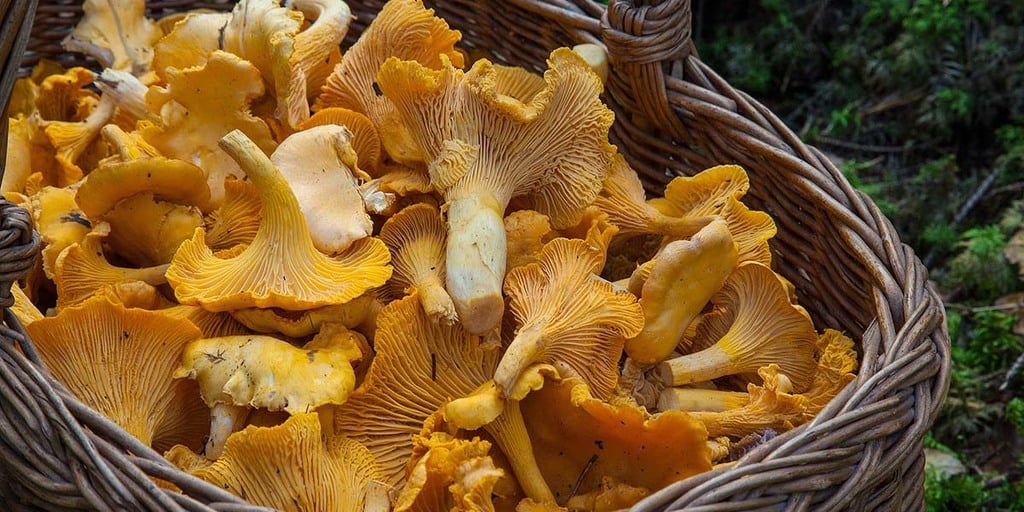
Chanterelle mushrooms actually include several different species of mushrooms in the Cantharellus, Gomphus, Polyozellus, and Craterellus families.
They’re close enough in appearance and taste that the name chanterelle is just used interchangeably for all of them.
Chanterelles are among some of the world’s most popular mushrooms. They’re funnel shaped and kind of look a bit like an oyster mushroom, in that they have very pronounced “gills” that run down into the stem.
The word chanterelle comes from the greek word kantharos, which means cup, a reference to the mushroom’s shape.
Chanterelles are commonly found in white, yellow, or orange colors. Many species of chanterelles have a pleasant and fruity smell, similar to apricots.
Their taste is a bit peppery.
How To Identify Chanterelle Mushroom
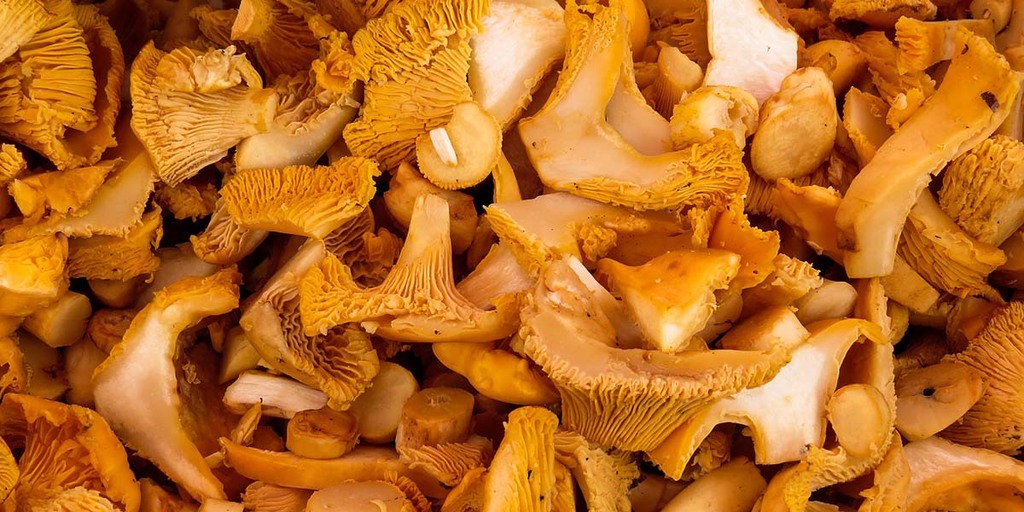
There are a few false mushrooms that look similar to chanterelles. Most notably the jack-o-lantern mushroom.
While not deadly, the jack-o-lantern mushrooms will cause very unpleasant vomiting, diarrhea, and severe cramps. Definitely something you want to avoid if at all possible.
Recognizing false gills is one of the most useful ways of identifying chanterelles and distinguishing them from lookalikes.
The false gills of a chanterelle are forked folds or wrinkles underneath the mushroom. These aren’t easily removable from the cap, and often look as if they melted on to the cap and step.
They can’t be separated without tearing the mushroom itself.
A chanterelle’s false gills run down the stem, referred to as being decurrent. The true gills of a mushroom are individual structures that can be easily separated from the cap.
Think of the gills underneath a portobello mushroom.
The “gills” of a chanterelle mushroom is smooth and full of forks. Whereas the true gills of false chanterelles are deep, paper-thin, and delicate.
The cap of a chanterelle mushroom is most commonly light yellow to orange-yellow color.
It can either be vase-shaped or convex. If you just picked it and it has a sweet smell like an apricot, then it’s most likely a chanterelle.
The stem should not be hollow. It should be the same color as the cap, with no bulb or ring around the base.
A chanterelle’s spore print is a white to light yellow color.
Tip: Do a spore print on a black piece of paper so it’s easier to see.
Jack-O-Lanterns
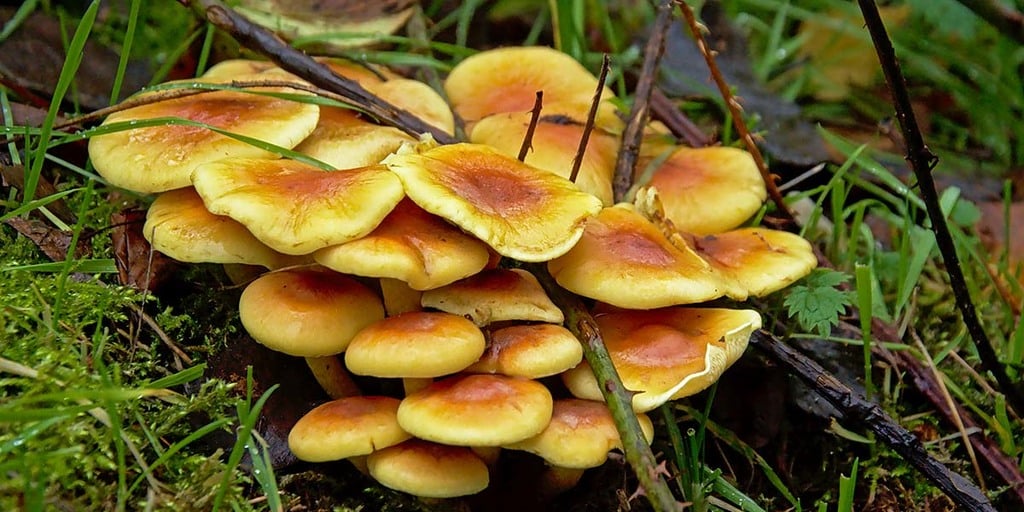
Omphalotus olearius or the jack-o-lantern mushroom is the most common chanterelle lookalike to watch out for. It won’t kill you, but it will have very unpleasant effects on your body if eaten. The toxin muscarine in it will cause severe cramps and diarrhea.
The gills are the first place to look when trying to distinguish a chanterelle from a jack-o-lantern. A jack-o-lantern’s gills are knife-like and not forked. Whereas chanterelles have false gills which are forked and appear melted.
The color of jack-o-lanterns are more orange and less yellow. But without a chanterelle to compare against, this might not be useful.
Jack-o-lanterns tend to grow in big groups with all of their stems attached. Chanterelles normally grow by themselves or in a small group with separate stems.
You can find jack-o-lanterns growing in the middle of fields or other areas with no trees around. Chanterelles are exclusively found near trees since they’re a mycorrhizal fungi that has a symbiotic relationship with tree roots.
If you aren’t 100% sure that you’ve positively identified a chanterelle mushroom, don’t eat it. There are too many other similar mushrooms that will make you sick to bother taking a chance on it. When in doubt, throw it out!
Where Do Chanterelle Mushrooms Grow?
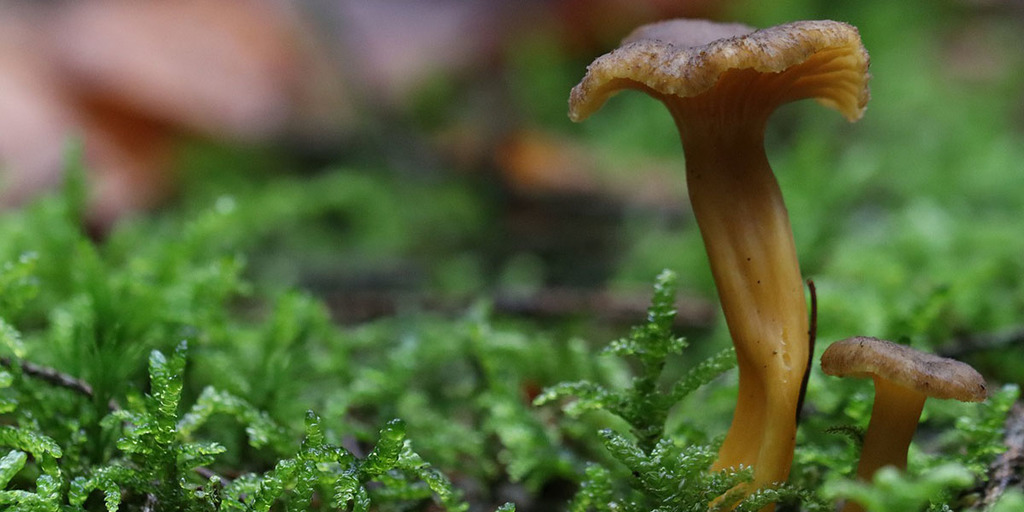
Chanterelles grow from late spring or mid summer into early fall. Depending on your area that might vary, but July to September is prime chanterelle season.
A chanterelle’s preferred habitat is in hardwood forests. These mushrooms are mycorrhizal, which means they form a symbiotic relationship with the roots of trees.
Oak, maple, poplar, and birch are among their favorite hardwood trees. But it’s also not uncommon to find them around white pine.
In forests you’ll find chanterelles on the edges of paths or roads where the ground has been disturbed, or around the edge of water sources like wetlands, streams, or other damp low-lying places.
Watch how the water is flowing, because water will often carry their spores downstream or downhill.
Anywhere with lots of organic matter, shade, and moisture is a prime habitat. If you have heavy rain for a day or two, followed by very humid hot days, that’s the perfect time for chanterelles to emerge.
- Read my full guide of How to Grow Mushrooms to learn more about growing mushrooms, different approaches, and more.
How To Forage For Chanterelle Mushrooms and Harvest Them

We’ve already touched on where and how chanterelles grow. Look during the summer in hardwood forests. Especially around water sources, and on humid days after heavy rain.
Walk carefully to avoid damaging the mycelium of chanterelles that the fruit bodies grow from, as it tends to live near the surface of the soil.
Bring along a small knife or a pair of scissors to cut chanterelles you come across.
Leaving the stem behind will help to prevent disturbing the soil, and makes it more likely that more mushrooms will grow from that spot in the future.
If I’m planning to return to an area, I’ll usually leave behind the smallest chanterelles. Keep track of where they are, and come back after a rain. They’ll normally be much larger and better for harvesting.
Bring along a basket large enough to hold several pounds of chanterelles. The mushrooms are fragile and if you put too many on top of each other, you risk bruising and crushing them.
I avoid chanterelles that are needlessly dirty. Big particles are easy enough to clean off, but dirt, sand, and other grit can be almost impossible to get out of a chanterelle’s forked false gills.
How To Grow Chanterelle Mushrooms
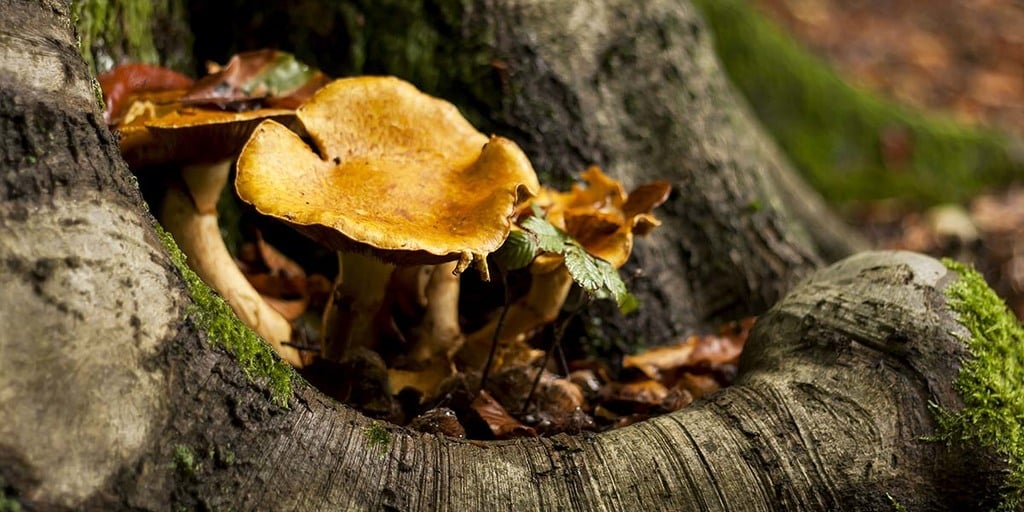
Growing chanterelle mushrooms isn’t as straightforward and simple as some other species like oyster mushrooms or shiitake, but it’s certainly doable.
1. Have Access To The Right Trees
In order to grow chanterelles in your backyard or anywhere else, you will need to have trees where you want them to grow.
That’s because they’re a mycorrhizal species of mushroom and need to live in tree roots to thrive.
Go with oak, beech, birch, spruce, or douglas fir trees for best success. Maple or poplar can also work but are less ideal.
2. Have The Right Soil
Chanterelle mushrooms grow best in soils with good drainage, low nitrogen levels and a low pH (acidic). The ideal pH level for chanterelles is between 4 and 5.5 pH..
If your soil pH is too low, you can add sodium carbonate (limestone).
If it’s too high, you can put aluminium sulfate in to make it more acidic. Getting the pH level is critical for getting the best chanterelle mushroom growth.
3. Pick The Right Time
Chanterelles grow best in moist environments when the weather isn’t too hot. July is a great month to pick, as it typically has the highest rainfall of the year.
Rainfall has a big affect on how fast and how large mushrooms will grow.
4. Loosen The Soil
When it’s time to start growing your chanterelles, you first need to rake or till the soil to get it nice and loose first.
The mushrooms won’t grow very well in a heavily compacted area. Be careful when walking around the area not to impact the soil.
5. Spread Your Spores
Chanterelles don’t produce as many spores as other types of mushrooms.
So the best way to get them in the ground is usually to take a few old chanterelle mushrooms, break them into pieces, and spread them over the area.
Alternatively you can buy a kit or set of chanterelle spawn to put into the area instead.
It might take years after planting pieces of a chanterelle before any mushrooms begin to grow. So be patient and do your best to avoid disturbing the area in the meantime.
6. Harvest
Once some chanterelles have grown, it’s time to harvest them.
You can just pull them out, but this has a chance of damaging the mycelium and lowering the odds that more mushrooms will re-grow in that area in the future.
7. Good Luck!
Growing chanterelles can be tricky and requires patience. But since these mushrooms are so delicious, it’s worth giving a try.
Remember that having the right kinds of trees, the right kind of soil, and proper weather will be the biggest determiners of your success.
What Do Chanterelle Mushrooms Taste Like?
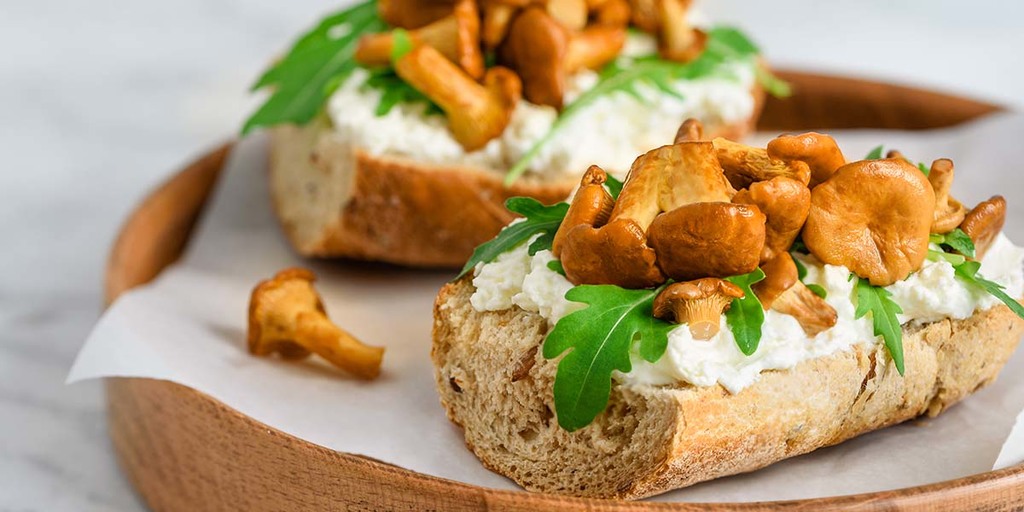
Although chanterelles have a fruity peach or apricot aroma when first picked, that isn’t an indication of how they taste. Chanterelles have an earthy or woodsy flavor and taste a bit like black pepper.
They have a velvety feel to them and they’re quite chewy. They’ve got a high moisture content compared to some other kinds of mushrooms.
How To Cook Chanterelle Mushrooms
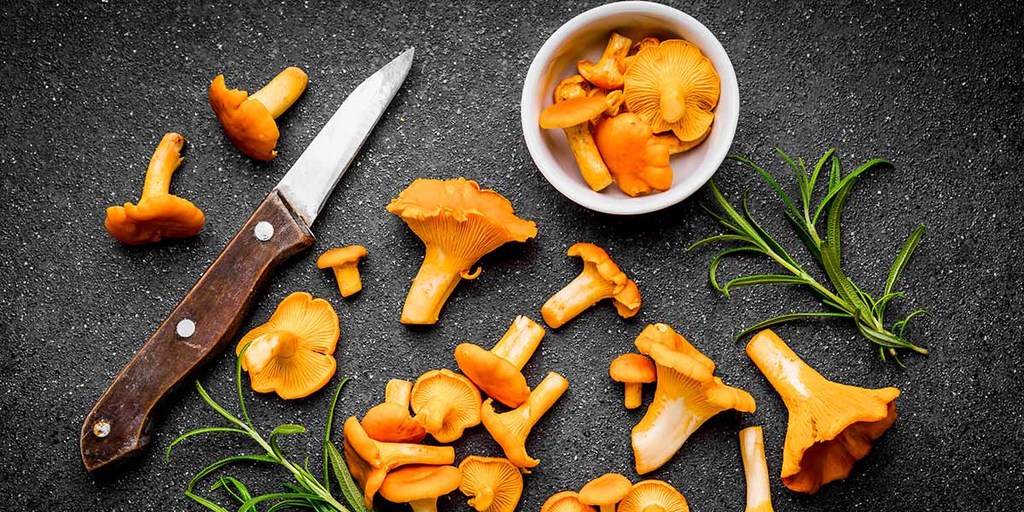
Chanterelles have been a part of French cuisine for hundreds of years, and have likely been eaten for much longer than that.
Golden chanterelles fall into a special category all unto their own. These are the most desired and flavorful type of chanterelle. They come at a high price to chefs, who often consider them just as good as morels or truffles.
Chanterelles are a diverse mushroom that can be cooked a number of different ways. They go well with butter, cream, oil, or wine.
They’re included in soups, cream sauces, souffles, and sautes. It’s uncommon for them to be eaten raw, since cooking really accentuates their flavors.
Chanterelles maintain their texture and aroma well even when dried, and some chefs even prefer to use reconstituted chanterelles.
The mushrooms are sometimes even crushed into a powder to be used as a seasoning for sauces and soups.
Good wines to pair with chanterelles include a dry white wine or a light red like a pinot noir. Use a heavier wine like a cabernet if the chanterelles are also being served with red meat.
Herbs that go well with this mushroom include chives, onions, shallots, tarragon, thyme, and garlic.
Pretty much any meat goes well with chanterelles. That includes beef, pork, chicken, fish, veal, eggs, and even wild game like venison.
- Read my full guide of How to cook mushrooms the right way here.
Storing Chanterelle Mushrooms
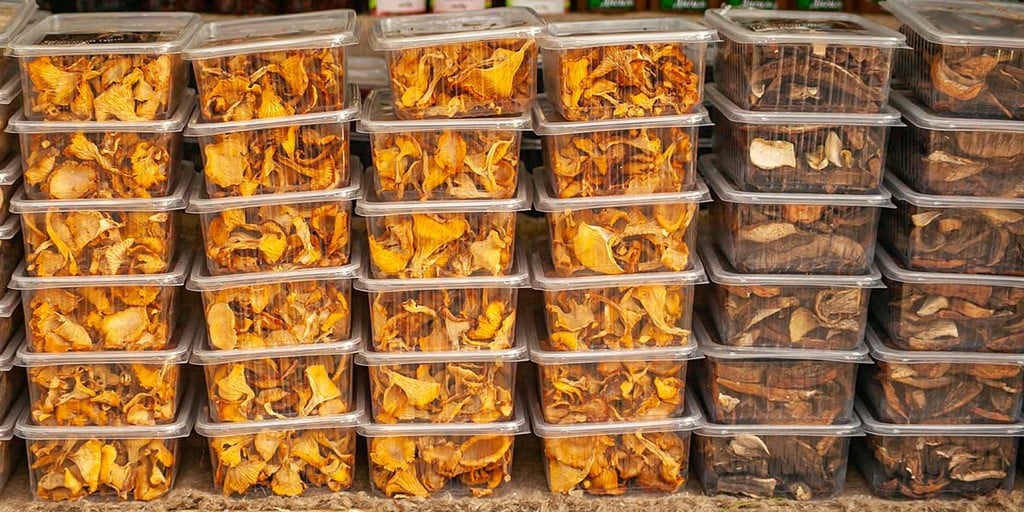
Whether you’re harvesting chanterelle mushrooms from the wild or your garden, the first step once you get them back into your kitchen is to clean them.
Not only do you need to clean the outside of your chanterelles and clean out all of the gills, but you need to pull them apart to clean inside the stem as well.
Sand and dirt tends to build up inside the stems of chanterelles for whatever reason. So without a proper cleaning, you might be setting yourself up for a rather gritty and sandy meal.
Better to take the time to properly clean them so that you don’t potentially ruin your dinner.
A toothbrush is my tool of choice when it comes to cleaning chanterelles. If you can get them reasonably clean, then they’re good for eating.
If they’re still quite dirty after you’ve taken a brush to them, they might not be good for much besides making soup stock.
Just make a stock with the mushrooms and then strain it through a coffee filter to remove any gritty bits.
Chanterelles are best when cooked from fresh. They’ll last about 10 days inside your refrigerator in a plastic bag. If you can’t eat them within that amount of time, they still taste great after they’ve been dried.
Dry them out in a food dehydrator, or in a baking tray in your oven on a low temperature. Just be sure to flip them regularly. To reconstitute dried chanterelles, just allow them to soak in water for a few minutes.
You can also freeze chanterelles. But saute them in butter first before freezing, as the texture won’t be as pleasant if you freeze them raw and then try to cook them.
Chanterelles can develop a bitter taste if kept frozen for too long, so still try to use them up within a couple of months.
Frequently Asked Questions
Q: Can you eat raw chanterelles?
A: Technically yes you can eat chanterelles raw, although very few people try. Their flavor doesn’t taste nearly as good as when cooked, and they can make some people ill.
Q: How quickly do chanterelles grow?
A: It depends on growing conditions. But once they begin to grow, it usually takes about 3 to 5 days for them to reach full size where they’re ready to harvest.
Q: Can you farm chanterelles?
A: Many people have tried to farm chanterelles, but it’s quite difficult due to their symbiotic relationship with trees. Not many people have been successful with it.
For beginners, I’d definitely recommend starting off with an easier variety like oyster mushrooms if you’re interested in growing.
Q: Should you wash chanterelles?
A: You should definitely brush your chanterelles off to try and remove as much dirt, sand, and grit as possible. Otherwise they will be much less pleasant to eat.
You can try rinsing them off in cold water, but avoid letting them soak for too long as they may absorb too much water.
Conclusion
Chanterelles are a popular edible mushroom, and their flavor is used in a wide variety of cooking. They go well with all kinds of different meats and sauces.
Growing chanterelles is possible, but it’s a lot more difficult than other species like oyster mushrooms.
They require the roots of specific species of trees and soil to really grow and thrive. And it can take several years after you innoculate the soil before you’ll get any mushrooms back.
Instead, it’s best to go foraging for chanterelles. Look in hardwood forests in mid to late summer. Especially on warm humid days after a heavy rain.
But like with all mushrooms, don’t attempt to eat it unless you’re 100% sure that you can positively identify them, or get help from an expert.
Some false chanterelles like the jack-o-lantern can cause some severe cramps and digestive problems.
If you want to learn more about types of mushrooms and how to grow them, read my articles below:
